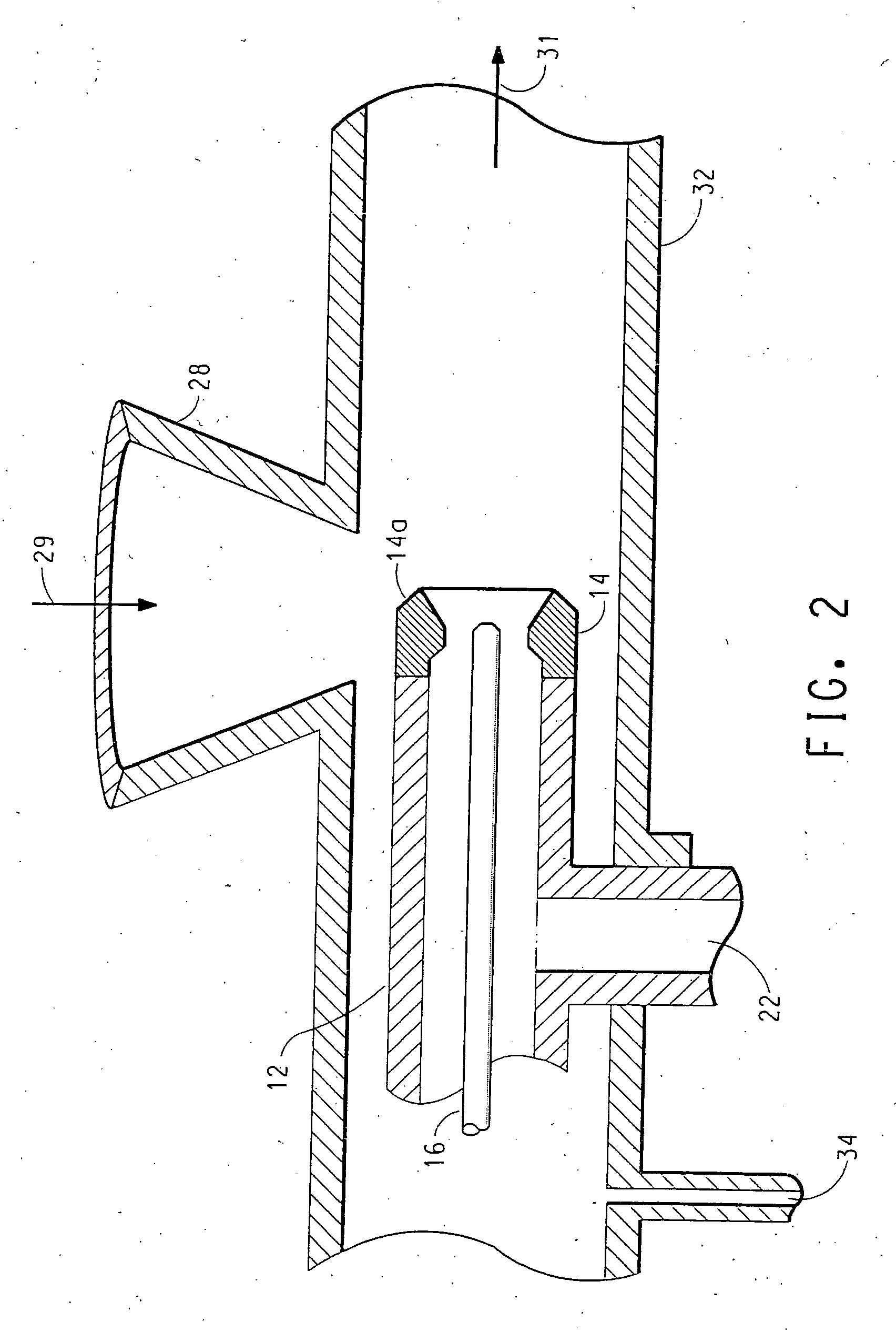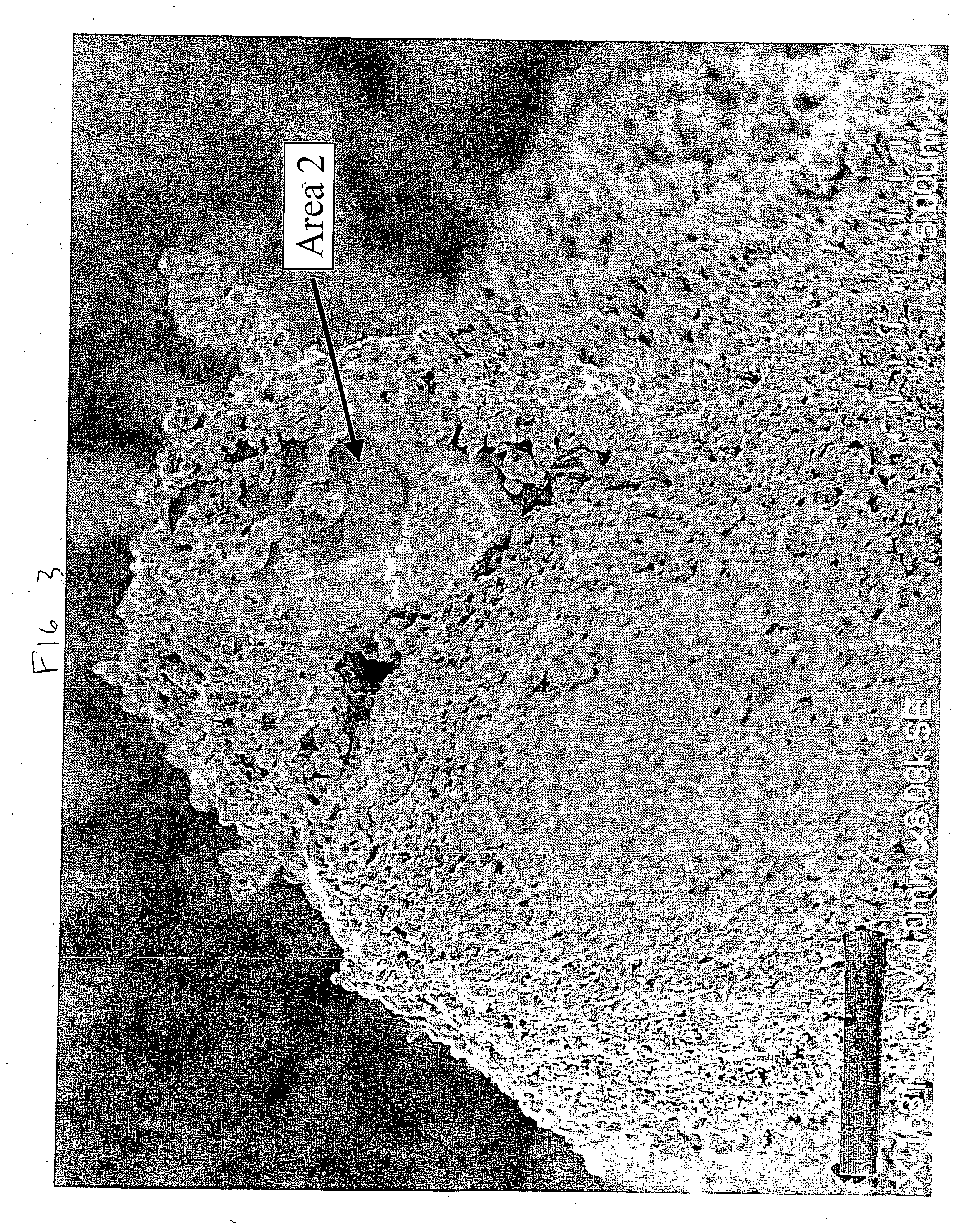Composition for controlled sustained release of a gas
a technology of controlled release and gas, which is applied in the direction of biocides, biocide, animal repellents, etc., to achieve the effects of rapid flow rate, short residence time, and high gas quantity
- Summary
- Abstract
- Description
- Claims
- Application Information
AI Technical Summary
Benefits of technology
Problems solved by technology
Method used
Image
Examples
example 1
[0118] A solution of sodium chlorite (NaClO2) was prepared by dissolving 30.0 parts technical grade (80% active) sodium chlorite in 70 parts high purity water (deionized and polished).
[0119] The solution was fed to an injector apparatus such as that shown in FIGS. 1 and 2 in order to treat titanium dioxide pigment particles R-101 sold by E. I. du Pont de Nemours and Company and Degussa P25. The titanium dioxide pigment was metered at a feed rate of 300 to 800 g / minute while the sodium chlorite solution feed rate was 50-250 g / minute. The gas stream was nitrogen which was injected through the flow restrictor at a pressure of 60 psig and the temperature of the gas stream was 325° C. The mean residence time in the zone of turbulence was about 1-2 milli-seconds.
[0120] The weight % amounts of sodium chlorite and chlorite ion based on the total weight of the catalyst and salt are shown in Table 1.
[0121] The gas stream was nitrogen which was injected through the flow restrictor at a pres...
example 2
[0122] A solution of sodium chlorite was prepared as described above. Dispersions of the titanium dioxide (R-101 and P25) in water were made at about 30-50 wt. % at pH 8-9 using 2-amino-2-methy-1-proparol to control pH. To this dispersion was added an amount of sodium chlorite solution and water to give about 18 wt. % titanium dioxide in water which was spray dried by atomization using nozzles at a temperature ranging from about 190 to about 220° C. The weight % amounts of sodium chlorite and chlorite ion based on the total weight of the catalyst and salt are shown in Table 2.
TABLE 2Spray DryerTiO2 Gradewt. % NaClO2wt. % ClO2−P255P2510R-10151.22R-101104.46
[0123] Comparing the data reported in Tables 1 and 2, it is apparent that the process of this invention for treating the titanium dioxide with the chlorite provides a composition with a higher concentration of chlorite ion as compared to spray drying. This is unexpected since spray drying uses lower temperatures and milder condit...
example 3
[0125] The energy activated catalysts of Table 3 were each treated with sodium chlorite following the procedure of Example 1 to produce treated samples.
[0126] The treated samples were exposed to ultra violet radiation using a 10 watt UV bulb at six 30-second intervals. The amount of ClO2 released was detected using an Interscan LD Series Model 33 ClO2 detector. The results are reported in Table 3.
TABLE 3ClO2 ppmSample30 sec.60 sec.90 sec.120 sec.150 sec.180 sec.TiO2 R-1012.96.28.510.010.811.5gradeZinc Oxide1.02.13.03.54.04.3Silicate Clay0.00.30.40.60.60.6
[0127] It is believed that silicate clay of this example which is considered to lack photoactivity produced a minor amount of ClO2 from direct photogeneration from the NaClO2.
PUM
| Property | Measurement | Unit |
|---|---|---|
| temperatures | aaaaa | aaaaa |
| pressure | aaaaa | aaaaa |
| pressure | aaaaa | aaaaa |
Abstract
Description
Claims
Application Information
 Login to View More
Login to View More - R&D
- Intellectual Property
- Life Sciences
- Materials
- Tech Scout
- Unparalleled Data Quality
- Higher Quality Content
- 60% Fewer Hallucinations
Browse by: Latest US Patents, China's latest patents, Technical Efficacy Thesaurus, Application Domain, Technology Topic, Popular Technical Reports.
© 2025 PatSnap. All rights reserved.Legal|Privacy policy|Modern Slavery Act Transparency Statement|Sitemap|About US| Contact US: help@patsnap.com



